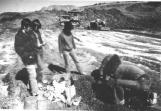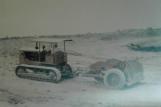15
This image shows bentonite in its raw form. When wet, the mineral is a peach or light brown colour and has a waxy texture.The bentonite from the Manitoba Escarpment has more calcium giving it its texture and making it a high commodity in comparison to other sources of bentonite with higher concentrations of sodium.
17
The first discovery of bentonite by E. H. Spencer in 1937 resulted in nineteen quarries mined by the mining company Pembina Mountain Clays over a span of 50 years.The overburden was removed to reveal the layers of bentonite. In some instances the overburden was 12-15 feet thick.
The pits or quarries were approximately 100 square feet and level. This picture shows a quarry being exposed.
19
The bentonite is found between layers of shale and alternates as such in the Pembina Member (rock group of the Pierre Shale Formation). The shale is the rock layer where the fossils at the Canadian Fossil Discovery Centre (formerly the Morden and District Museum) are found.It wasn't until 1972 that a local farmer told Henry Isaak, then a university student, that fossil teeth were found up in the Pembina Hills.
They went to investigate and discovered fossils all over the place.
The miners indicated that the fossils were common and were found all the time.
21
In the late 1930's mining for bentonite began and operation techniques consisted of wheel barrows and old fashioned manual labour. By the 1970's the introduction of heavy machinery to the quarries increased production by 300%, says bulldozer operator Roy Friesen.Basic techniques to mine the bentonite included a bulldozer, a scraper and then a crew behind the scraper.
Roy Friesen is seen in the picture. He was the only bulldozer operator.






